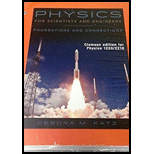
A system consisting of 10.0 g of water at a temperature of 20.0°C is converted into ice at –10.0°C at constant atmospheric pressure. Calculate the total change in entropy of the system. Assume the specific heat of water is 4.19 × 103 J/(kg · K), the specific heat of ice is 2.10 × 103 J/(kg · K), and the latent heat of fusion is 3.33 × 105 J/kg.
The total change in entropy of the system.
Answer to Problem 71PQ
The total change in entropy of the system is
Explanation of Solution
Write the expression to calculate the entropy change when
Here,
Write the expression to calculate the entropy change for the transformation of phase from ice to water.
Here,
Write the expression to calculate the change in entropy of the ice to decrease the temperature from
Here,
Write the expression to calculate the entropy change for the whole process.
Here,
Conclusion:
Substitute
Substitute
Substitute
Substitute
Therefore, the total change in entropy of the system is
Want to see more full solutions like this?
Chapter 22 Solutions
Physics for Scientists and Engineers: Foundations and Connections
- In an isochoric process, heat is added to 10 mol of monoatomic ideal gas whose temperature increases from 273 to 373 K. What is the entropy change of the gas?arrow_forwardWhich of the following is true for the entropy change of a system that undergoes a reversible, adiabatic process? (a) S 0 (b) S = 0 (c) S 0arrow_forwardTwo moles of a monatomic ideal gas such as oxygen is compressed adiabatically and reversibly from a state (3 atm, 5 L) to a state with a pressure of 4 atm. (a) Find the volume and temperature of the final state. (b) Find the temperature of the initial state. (c) Find work done by the gas in the process. (d) Find the change in internal energy in the process. Assume Cv=5R and Cp=Cv+R for the diatomic ideal gas in the conditions given.arrow_forward
- Suppose 20 g of ice at 0 is added to 300 g of water at 60 . What is the total change in entropy of the mixture after it reaches thermal equilibrium?arrow_forwardDoes the entropy increase for a Carnot engine for each cycle?arrow_forwardThe energy output of a heat pump is greater than the energy used to operate the pump. Why doesn't this statement violate the first law of thermodynamics?arrow_forward
- In a diesel engine, the fuel is ignited without a spark plug. Instead, air in a cylinder is compressed adiabatically to a temperature above the ignition temperature of the fuel; at the point of maximum compression, the fuel is injected into the cylinder. Suppose that air at 20 C is taken into the cylinder at a volume V1 and then compressed adiabatically and quasi-statically to a temperature of 600 C and a volume V2 . If =1.4 , what is the ratio V1/V2 ? (Note: static. In an operating diesel engine, the compression is not quasi-arrow_forwardWhat is the entropy change of 10 g of steam at 100 when it condenses to water at the same temperature?arrow_forwardTrue or False: The entropy change in an adiabatic process must be zero because Q = 0.arrow_forward
- A Carnot engine operates between 550 and 20 baths and produces 300 kJ of energy in each cycle. Find the change in entropy of the (a) hot bath and (b) cold bath, in each Carnot cycle?arrow_forwardAn ice tray contains 500 g of liquid water at 0C. Calculate the change in entropy of the water as it freezes slowly and completely at 0C.arrow_forwardAn athlete whose mass is 70.0 kg drinks 16.0 ounces (454 g) of refrigerated water. The water is at a temperature of 35.0F. (a) Ignoring the temperature change of the body that results from the water intake (so that the body is regarded as a reservoir always at 98.6F), find the entropy increase of the entire system. (b) What If? Assume the entire body is cooled by the drink and the average specific heat of a person is equal to the specific heat of liquid water. Ignoring any other energy transfers by heat and any metabolic energy release, find the athletes temperature after she drinks the cold water given an initial body temperature of 98.6F. (c) Under these assumptions, what is the entropy increase of the entire system? (d) State how this result compares with the one you obtained in part (a).arrow_forward

 Principles of Physics: A Calculus-Based TextPhysicsISBN:9781133104261Author:Raymond A. Serway, John W. JewettPublisher:Cengage Learning
Principles of Physics: A Calculus-Based TextPhysicsISBN:9781133104261Author:Raymond A. Serway, John W. JewettPublisher:Cengage Learning Physics for Scientists and EngineersPhysicsISBN:9781337553278Author:Raymond A. Serway, John W. JewettPublisher:Cengage Learning
Physics for Scientists and EngineersPhysicsISBN:9781337553278Author:Raymond A. Serway, John W. JewettPublisher:Cengage Learning Physics for Scientists and Engineers with Modern ...PhysicsISBN:9781337553292Author:Raymond A. Serway, John W. JewettPublisher:Cengage Learning
Physics for Scientists and Engineers with Modern ...PhysicsISBN:9781337553292Author:Raymond A. Serway, John W. JewettPublisher:Cengage Learning College PhysicsPhysicsISBN:9781305952300Author:Raymond A. Serway, Chris VuillePublisher:Cengage Learning
College PhysicsPhysicsISBN:9781305952300Author:Raymond A. Serway, Chris VuillePublisher:Cengage Learning College PhysicsPhysicsISBN:9781285737027Author:Raymond A. Serway, Chris VuillePublisher:Cengage Learning
College PhysicsPhysicsISBN:9781285737027Author:Raymond A. Serway, Chris VuillePublisher:Cengage Learning





